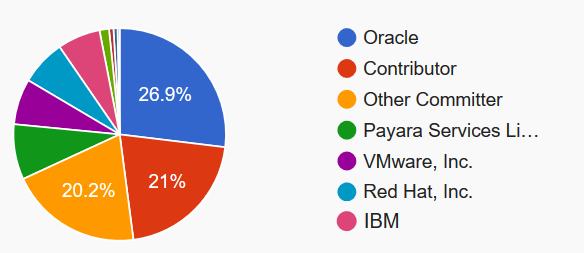With the results of the 2020 Jakarta EE survey and the initial milestone release of the Jakarta EE 9, it’s clear the community’s collective efforts are resonating with the global Java ecosystem.
Before I get to the survey results, I want to say a huge thank you to everyone who took the time to participate in the survey. We received nearly 2,200 responses from software developers, architects, and decision-makers around the world — an increase of almost 20 percent over last year’s survey. With your insight, we’ve gained a clear and comprehensive view of enterprise Java strategies and priorities globally, which in turn we are freely sharing with the ecosystem.
Jakarta EE Adoption and Compatible Implementations Are on the Rise
Less than a year after its initial release, Jakarta EE has emerged as the second-place cloud native framework with 35 percent of respondents saying they use it. While the Spring and Spring Boot frameworks are still the leading choices for building cloud native applications, their usage share dropped 13 percent to 44 percent in the 2020 survey results.
Combined, Java EE 8 and Jakarta EE 8 hit the mainstream with 55 percent adoption. Jakarta EE 8 was responsible for 17 percent of that usage, despite only shipping for the first time in September 2019. This is truly significant growth.
We’re also seeing a strong uptick in Jakarta EE 8 compatible products. Companies including IBM, Red Hat, Payara, Primeton, TmaxSoft, and Apusic now have Jakarta EE 8 Full Platform compatible products. Since January 2020, we’ve had four new Full Platform compatible implementations and one new Web Profile compatible implementation. In addition to Eclipse GlassFish 5.1, this brings Jakarta EE 8 adoption to 12 compatible products. This is an outstanding achievement for the Jakarta EE community to have more full platform compatible products in 8 months than Java EE 8 had in over 2 years. You can see the complete list here.
You can also expect to see additional compatible implementations in the coming months as more applications are passing Technology Compatibility Kit (TCK) tests and are well on their way to becoming certified as Jakarta EE 8-compatible products.
Architectural Approaches Are Evolving
This year’s Jakarta EE survey also showed a slight drop in the popularity of using a microservices architecture for implementing Java systems in the cloud compared to last year. At the same time, use of monolithic architectures for implementing Java systems in the cloud nearly doubled since last year’s survey and is now at 25 percent.
These results may indicate that companies are pragmatically choosing to simply “lift and shift” existing applications to the cloud instead of rearchitecting them as microservices.
Interestingly, the survey also indicated the Jakarta EE community would like to see better support for microservices in the platform. When you combine this fact with the rise of Jakarta EE, it’s reasonable to believe developers may be starting to favor vendor-neutral standards for building Java microservices over single-vendor microservices frameworks.
The Industry Is Moving to the New Jakarta EE Namespace
The support we’re seeing for the adoption of the new namespace in Jakarta EE 9 reinforces the value the industry sees in Jakarta EE. Technology leaders are already investing to ensure their software supports the Jakarta EE 9 namespace changes and others have indicated they will do the same. Some of these implementations include:
- Eclipse GlassFish 6.0 milestone release is available to download
- Jetty 11.0.0-alpha0 milestone release is available to download
- Apache Tomcat 10.0 M6 milestone release is available to download
- Payara Platform 6 milestone release coming in Q4 2020
- OpenLiberty 20.0.0.7 Beta release is available with basic Web application support to download
- Apache TomEE 9.0 milestone release using Eclipse Transformer project tools is available to download
- WildFly 21 is planning a milestone release for fall 2020
- Piranha Micro p20.6.1 milestone release is available to download.
While the Jakarta EE 9 tooling release doesn’t include new features, it’s a very important and necessary step on the road to Jakarta EE 10 and the next era of innovation using cloud native technologies for Java. With the full Jakarta EE 9 release in fall this year, Jakarta EE will be ideally positioned to drive true open source, cloud native innovation using Java.
Diversity, Achieved
One of the items that I am particularly happy about is the achievement of establishing Jakarta EE as a vendor-neutral, community-led technology platform. When we started the process of moving Java EE from Oracle to the Eclipse Foundation there were some who doubted that it could be accomplished successfully. The numbers tell the story: Oracle’s contributions are still leading the pack at 27%, but the community-at-large is

now over 40%. Contributions from our other members are led by Payara, VMware (Pivotal), Red Hat, and IBM. Based on these results, it is clear that Jakarta EE has truly achieved its original objective of becoming a vendor-neutral, community-led industry initiative. A lot of people worked very hard to achieve this, and I’m thrilled by the results.
Discover Jakarta EE
Here are three ways to learn more about Jakarta EE and understand why it’s gaining mainstream adoption so quickly:
- Join the community at the Jakarta EE 9 Milestone Release Virtual Party and networking opportunity on Tuesday, June 23 at 11:00 a.m. EDT. To register for the event, click here.
- Find out more about the Jakarta EE 9 milestone release here.
- Review the complete 2020 Jakarta EE Survey results here.
Edit: Reflect IBM’s contributions
Edit #2: Add link to Apache TomEE download
